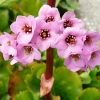Features
This useful garden plant forms spreading clumps of rounded, glossy green leaves which have wavy edges. The evergreen foliage turns an attractive purple/bronze colour in the winter.
Between February and April red flower stems grow up to 60cm tall and bear rose pink, bell-shaped flowers.
What to use it for
The dense foliage and unfussy nature of this plant makes it ideal as ground cover or path edging in beds, border, banks/slopes and woodlands. The leaves can be used in flower arrangements, particularly in winter when they change colour.
The pretty pink flowers look great in cottage style gardens, while the architectural appearance of the leaves make it a useful addition to more modern or urban styles.
How to look after it
This is a low maintenance plant, though it benefits from division every 3 to 5 years to keep it compact.
How to prune it
In the spring cut off tatty foliage and deadhead to remove faded flower spikes.
How to propagate it
The simplest way to propagate this plant is by division, which can be done in autumn or after flowering in the spring. As the rhizomes lengthen on older plants, new rosettes of leaves will grow at the tips of them (“plantlets”). These rhizomes can be severed from the parent plant, ensuring that you have 15cm of rhizome with roots and a healthy rosette of leaves on the section removed. Trim off any large leaves to minimise water loss, then replant in its new location so the rhizome is just under the soil surface.
Seeds can be collected in the summer and sown in the spring. Sow the seeds in trays. They should germinate in 3 to 6 weeks and flower in 2 years.
Rhizome cuttings can be taken in autumn or after flowering in the spring. Dig out a thick, healthy rhizome with no leaves on it and slice it into 4 to 5cm sections, each section including several dormant buds. Trim any long roots off each section. Half bury the cuttings (so the upper surface is uncovered), buds upwards, 5cm apart in trays of moist compost or perlite. Put the tray in a propagator or cover it with a sheet of glass/plastic to keep it humid, shade it and maintain a temperature of 21C. The cuttings should root in 10 to 12 weeks. As the new plants put on leaf, pot them on or plant them out in a nursery bed. The new plants should flower in 1 to 2 years.
Common problems
Bergenias can be susceptible to attacks form slugs, snails, vine weevils, leaf eelworms and caterpillars. The leaves can suffer from fungal leaf rots and the rhizomes may be affected by rhizome rot.
Other useful information
The common names ‘heart-leaf’ and ‘elephant’s ear’ derive from the shape of the leaves, while ‘pigsqueak’ refers to the noise that can be made by rubbing the leaves together.
The genus name, which was given by botanist Conrad Moench in 1794, Bergenia honours the German botanist and physician Karl August von Bergen (1704-1759).








